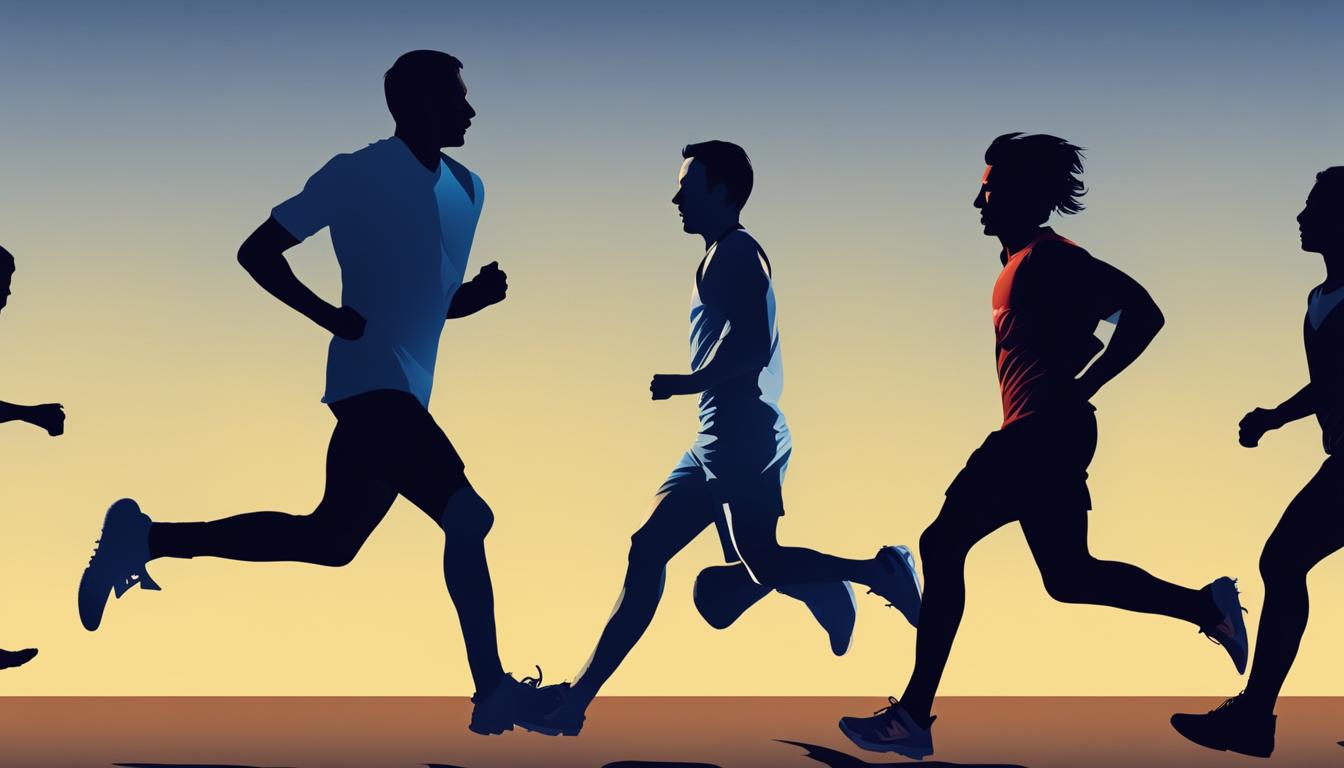Running wasn’t invented but evolved naturally with human development. Its origins trace back millions of years to the emergence of bipedal locomotion in our early ancestors. Around 6 to 7 million years ago, humans began walking on two legs, and by 2 million years ago, we’d developed the ability to run long distances. This skill proved essential for survival, enabling persistence hunting and escape from predators. Over time, running transformed from a necessity to a competitive and recreational activity. Ancient civilizations like Greece and Rome formalized running events, laying the groundwork for modern athletics. The story of running’s evolution is a fascinating journey through human history.
Origins of Bipedal Locomotion

Humanity’s journey towards running began millions of years ago with the evolution of bipedal locomotion. You might be surprised to learn that our ancestors first stood upright around 6 to 7 million years ago. This vital development set the stage for the running abilities we possess today.
As early humans evolved, their bodies adapted to walking and running on two legs. By 4 million years ago, species like Australopithecus afarensis had developed skeletal structures that allowed for efficient bipedal movement. These changes included longer legs and adaptations in the pelvis. Around 3 million years ago, the human foot evolved further, developing an arch and aligned toes that enhanced stability and efficiency in running.
These anatomical changes were pivotal in shaping human running capabilities. Bipedal locomotion allowed early humans to travel longer distances, which was essential for foraging and hunting. This ability to cover ground efficiently contributed to the development of endurance running as a survival skill. By about 2 million years ago, modern human running capabilities had emerged, marking a significant milestone in our evolutionary history.
Evolutionary Advantages of Running
Running’s evolutionary advantages stretch back millions of years, shaping human survival and development. As early humans evolved, their ability to run long distances became an essential survival skill. You might be surprised to learn that running played a significant role in how our ancestors hunted and gathered food.
One of the most fascinating theories about early human hunting is called persistence hunting. This method relied on our ancestors’ ability to chase prey over long distances, eventually exhausting the animal. While other predators might be faster in short bursts, humans could maintain a steady pace for hours. This endurance gave early humans a unique evolutionary advantage, allowing them to secure food and survive in challenging environments.
Running also helped our ancestors escape predators and communicate across vast landscapes. These abilities shaped social structures and group dynamics in early human societies. As you can see, the importance of running goes far beyond just physical fitness. It’s a fundamental part of our evolutionary history, influencing how we developed as a species and ultimately shaping the world we live in today.
Ancient Persistence Hunting Techniques

A remarkable hunting technique employed by our ancestors, persistence hunting, showcases the ingenuity and physical prowess of early humans. This method, dating back approximately 2 million years, involved chasing prey over long distances until the animal became exhausted. You might wonder how our ancestors managed such feats of endurance. The answer lies in their anatomy, which evolved to support long-distance running. This evolutionary advantage is similar to the common running injuries faced by modern runners, emphasizing the importance of understanding our body’s mechanics and strengths. As with injury prevention strategies, early humans likely benefited from their anatomical adaptations to reduce the risk of strain during these prolonged chases.
As a survival strategy, persistence hunting required cooperation among group members. Hunters would take turns leading the chase, allowing others to rest and conserve energy. This teamwork increased their chances of a successful hunt. Evidence of this technique can be found in fossil records, which show adaptations like the Achilles tendon and upright posture that aided in long-distance running.
Interestingly, persistence hunting isn’t just a relic of the past. Modern studies of indigenous cultures, such as the San people in Botswana, demonstrate that this method is still effective today. By understanding these ancient techniques, you can appreciate how human endurance and strategic thinking have shaped our evolutionary journey.
Early Human Anatomical Adaptations
Our ancestors’ ability to engage in persistence hunting was closely tied to their evolving anatomy. Early humans developed key anatomical adaptations that enabled them to excel at long-distance running. These changes began around 2 million years ago, but the foundation was laid even earlier with the emergence of bipedalism 6 to 7 million years ago.
You might be surprised to learn that your body has unique features designed specifically for running. Your Achilles tendon, for example, acts like a spring, storing and releasing energy with each step. Your elongated legs and stable knee joints provide efficiency and stability during movement. Even the arch of your foot contributes to your running ability, absorbing shock and propelling you forward.
These adaptations weren’t just for leisure; they were essential for survival. Persistence hunting, a technique where early humans would chase prey to exhaustion, relied on these anatomical changes. This method showcased human endurance rather than raw speed. Fossil evidence from species like Australopithecus afarensis reveals how our ancestors’ bodies gradually changed to support this running-based lifestyle, setting humans apart from other animals regarding long-distance running capabilities.
Running in Prehistoric Societies
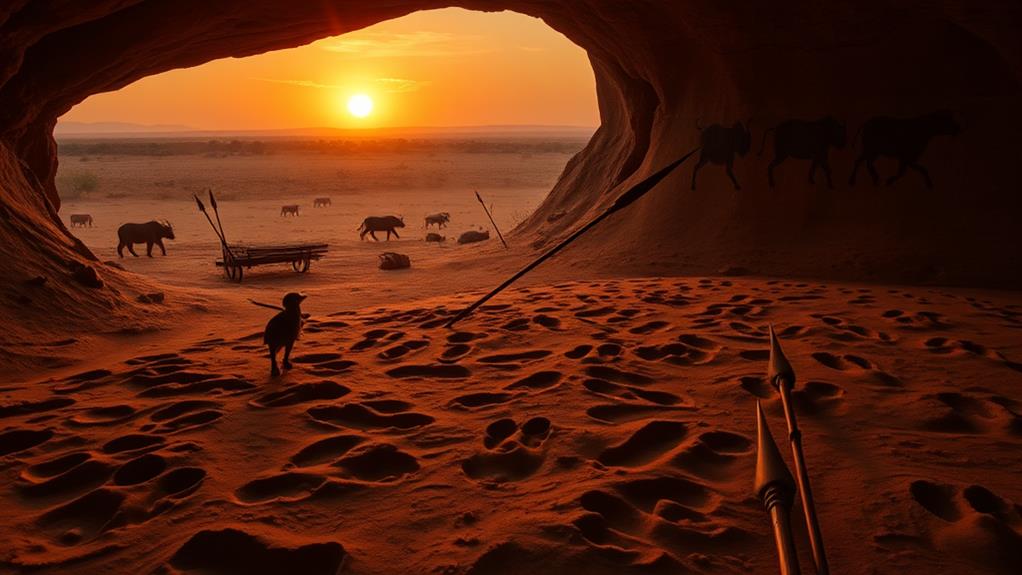
Throughout prehistoric societies, running played an essential role in human survival and development. You can imagine early humans relying on their running abilities to escape predators, hunt for food, and travel long distances. The evolution of bipedalism was a key factor in developing running as a vital skill for survival.
One fascinating aspect of running for survival was persistence hunting. This technique involved early humans chasing prey over long distances, using their superior endurance to exhaust the animals. You might picture groups of hunters taking turns as lead runners, maintaining their stamina during these prolonged chases.
As time passed, running shifted from a necessity to a competitive activity. The first recorded competitive running events can be traced back to the Tailteann Games in Ireland, occurring between 600 and 1100 B.C. This marks a significant change in how humans viewed running, transforming it from a purely survival-based activity to a structured form of competition and entertainment.
Understanding the origins of running provides valuable insights into human evolution and the development of our physical abilities. It’s a reflection of our species’ adaptability and endurance.
Ancient Greek Running Traditions
Ancient Greece’s running traditions form the cornerstone of modern competitive athletics. You’ll find that running as a sport was formalized in the ancient Olympic Games, with the first recorded event in 776 BCE. This footrace, called the stade, was a short sprint of about 200 meters. As the games evolved, longer races like the diaulos and dolichos were introduced, showcasing athletes’ speed and endurance.
The ancient Greeks didn’t limit running to the Olympics. They celebrated athletic prowess through various festivals honoring their gods, particularly Zeus. These events highlighted the cultural significance of running in their society. You might be surprised to learn that running wasn’t just for competition; it also served practical purposes. The legendary run of Pheidippides from Marathon to Athens in 490 BCE demonstrates how running was used for communication in ancient times.
It’s important to note that ancient civilizations beyond Greece also valued running. The Tailteann Games in Ireland, dating back to around 1600 BCE, included running events. This shows that the appreciation for running as a competitive sport was widespread across different cultures in the ancient world.
Roman Empire’s Running Cultures
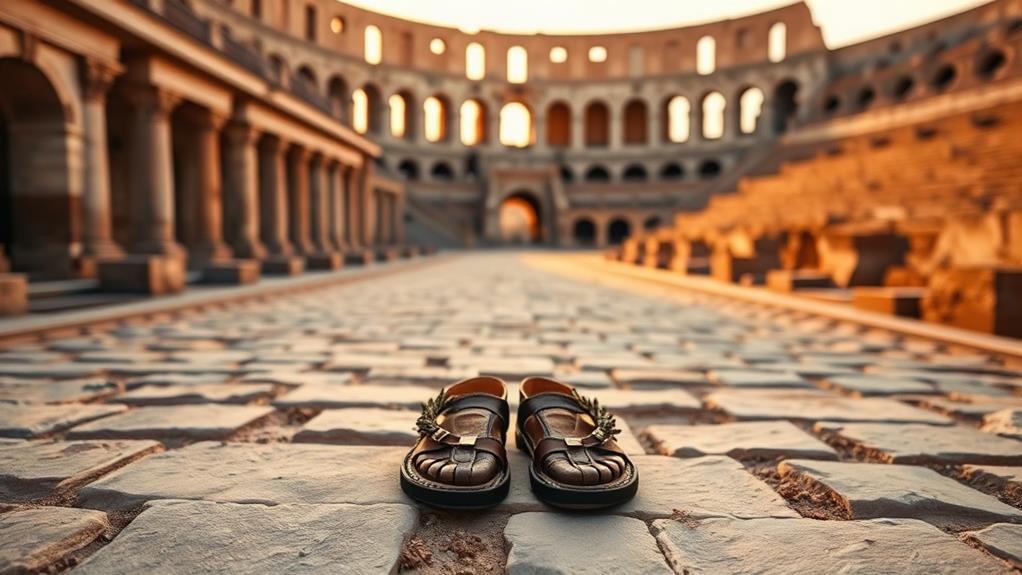
As the influence of ancient Greece waned, the Roman Empire emerged as a powerhouse that embraced and expanded upon running traditions. You’d find running deeply ingrained in Roman culture, serving multiple purposes beyond mere transportation. The Romans organized various competitive events, with running races taking center stage alongside chariot racing and gladiatorial contests in the famous Roman Games, known as Ludi.
In 146 BC, General Scipio Aemilianus introduced the concept of a “racecourse” for organized athletic competitions, formalizing running events within the empire. This development highlighted the cultural significance of running and the Romans’ appreciation for athletic prowess. You’d see soldiers engaging in running as part of their military training, as the empire valued physical fitness for both endurance and speed. Notable Roman authors like Juvenal and Pliny the Elder even referenced running in their works, further emphasizing its importance in society. Through these practices and events, the Roman Empire solidified running’s place as both a competitive sport and a vital element of their culture, leaving a lasting impact on the activity’s evolution.
Mayan Long-Distance Messengers
Messengers on foot played a pivotal role in Mayan civilization, showcasing the importance of running beyond mere sport or survival. These long-distance runners, known as “runners” or “messengers,” were essential for communication between city-states, often covering astonishing distances of up to 150 miles in a single day. You can imagine the level of endurance required for such feats, as these individuals were trained to maintain their pace over vast territories.
The Mayan civilization relied heavily on these runners, especially during times of war or when urgent news needed to be delivered. To facilitate their swift passage, the Mayans constructed a network of roads called “sacbeob” or white roads. These specially designed pathways allowed runners to travel quickly and efficiently across the empire.
Running wasn’t just a practical necessity for the Mayans; it was a respected skill that required rigorous physical conditioning. The ability to run long distances was highly valued, reflecting the cultural significance of endurance and agility in Mayan society. This system of long-distance messengers highlights the ingenious ways ancient civilizations adapted running for their specific needs.
Native American Running Practices

Native American cultures have long embraced running as a cornerstone of their way of life, much like the Mayans did with their messenger system. You’ll find that native american running practices served multiple purposes, including communication, hunting, and spiritual ceremonies. These traditions have been passed down through generations, with many tribes still engaging in running events today to preserve their cultural heritage.
One of the most impressive examples of long-distance running comes from the Tarahumara people of Mexico. They’re known for participating in races that can exceed 100 miles, emphasizing endurance and community. Similarly, the Inca civilization used runners called “chasquis” to deliver messages across vast distances, often covering 150 miles in a single day.
Running was also integral to community gatherings and rituals. The Pacific Northwest tribes, for instance, held running games like the “running of the bears,” which combined athletic skill with storytelling. These events not only showcased physical prowess but also strengthened social bonds within the community. Today, many Native American tribes continue to organize running events as a way to celebrate their rich cultural heritage and promote physical well-being.
Medieval European Foot Races
During the Middle Ages, you’d find Europeans engaging in organized footraces as part of their festivals and celebrations. These competitive events showcased local athletic talent and often held cultural significance. Medieval footraces varied in length and purpose, with some even serving as military training exercises.
To paint a picture of these medieval running events, imagine:
- Enthusiastic crowds lining the streets of a bustling town square
- Runners in simple clothing, barefoot or wearing basic shoes
- A town crier announcing the start of the race with a loud bell
- Spectators cheering and placing friendly wagers on their favorites
One of the earliest recorded competitive running events in medieval Europe was a hill race in Scotland, taking place between 1040 and 1064. This illustrates the longstanding tradition of organized running competitions in the region. As time progressed, these footraces became more structured and widespread, laying the foundation for modern running events. The Crick Run, established in England in 1838, is a prime example of how these medieval traditions evolved into formalized competitions, paving the way for the sport we recognize today.
Renaissance Era Running Events
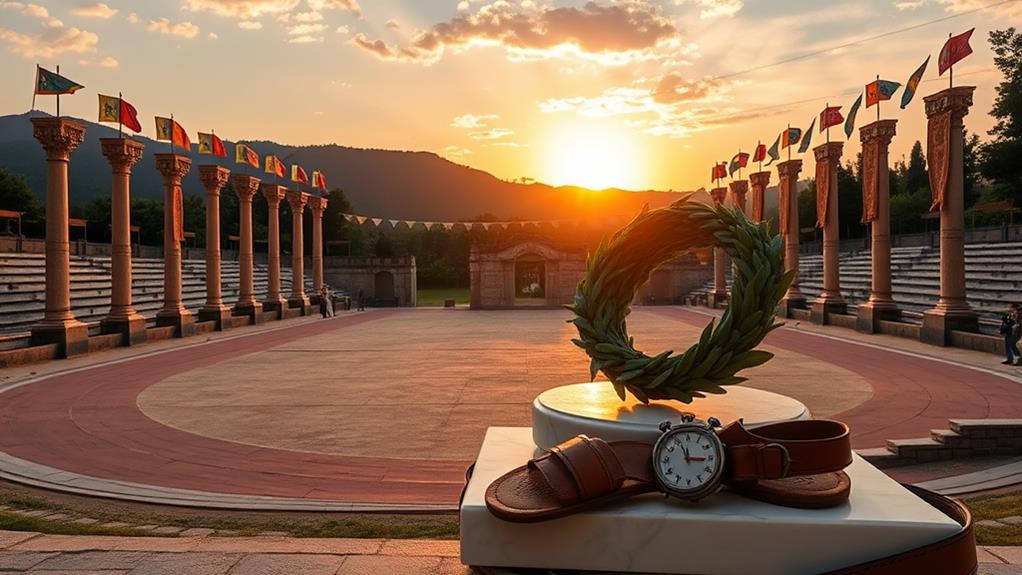
As the Renaissance ushered in a renewed focus on human potential, running events flourished across Europe. You’d have seen a surge in athletic competitions that included foot races, reflecting the era’s emphasis on physical fitness and humanism. These organized races weren’t just for show; they served practical purposes too.
In the 16th century, you’d have found running races integrated into military training regimens and local celebrations. They tested both speed and endurance, skills valued in soldiers and civilians alike. If you’d visited Italy during this time, you might have witnessed the “Giostra” tournaments, where running played a key role alongside jousting. Meanwhile, in France, the royal courts elevated running to a noble pursuit. This led to races that drew participants from various social classes, increasing the sport’s visibility and appeal.
As the Renaissance progressed, running events became more structured and documented. This shift laid the groundwork for modern athletics, establishing traditions that you’d recognize in today’s competitive running world. The Renaissance era truly marked a turning point in the evolution of running as a sport.
Birth of Competitive Track
Tracing the birth of competitive track takes us back to ancient civilizations. The Tailteann Games in Ireland, around 1600 BC, marked the first recorded competitive running events. These games included various athletic disciplines, setting the stage for future competitions. The ancient Olympic Games, beginning in 776 BC in Olympia, Greece, further solidified running’s place in competitive sports. Initially featuring short sprints like the stade race, the Olympics evolved to include longer distances over time. To achieve personal bests in modern competitive running, athletes often rely on personalized marathon training plans that cater to their unique strengths and fitness levels.
The marathon, a cornerstone of modern competitive running, has its roots in ancient history. Here’s a glimpse into its development:
- Inspired by Pheidippides’ legendary run in 490 BC
- Introduced in the modern Olympics in 1896
- Standardized to 26.2 miles during the 1908 London Olympics
- Boston Marathon, established in 1897, became the oldest annual marathon
As competitive track grew, it transformed from a survival skill to a celebrated sport. The standardization of events and distances, like the marathon, helped establish a framework for modern competitive running. Today, track and field competitions continue to captivate audiences worldwide, showcasing human endurance and speed.
First Modern Olympic Games
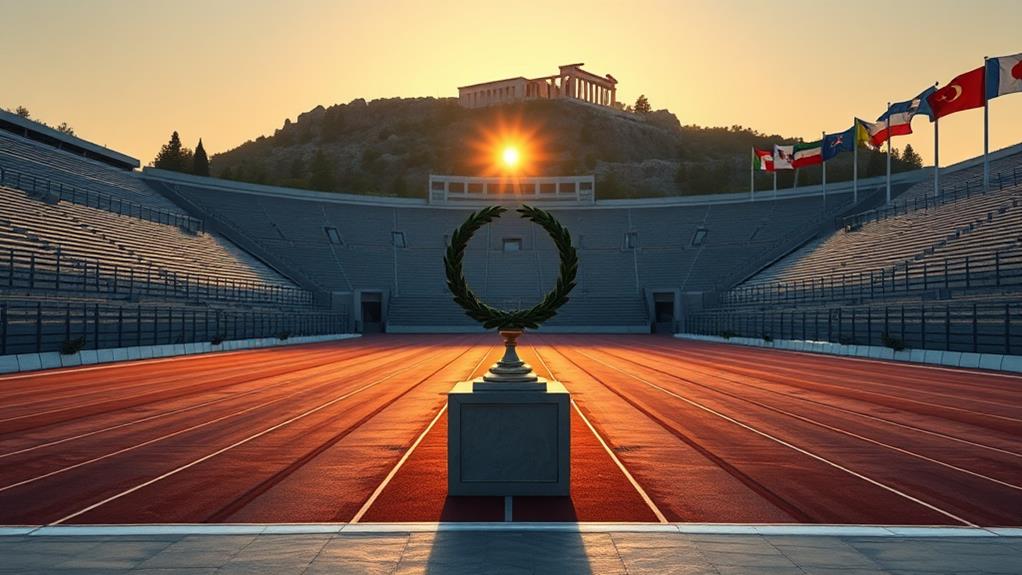
In 1896, the first modern Olympic Games breathed new life into the ancient tradition of athletic competition. Held in Athens, Greece, these games marked a significant revival of the ancient games and set the stage for the future of international sports. As athletes began to train more systematically, training and preparation strategies became essential for performance. You’ll find that the 1896 Olympics featured only male athletes, as women were excluded from participation in all events during this inaugural modern iteration.
One of the most notable events was the marathon, which quickly became a centerpiece of the games. Spyridon Louis, a Greek runner, won the first Olympic marathon with a time of 2:58:50. It’s worth mentioning that the marathon distance wasn’t standardized until 1921, with the original 1896 race measuring about 24.85 miles. The success of the marathon in these games laid the foundation for its inclusion in future Olympics and contributed to the growth of long-distance running as a competitive sport. The 1896 Olympics not only revived the spirit of the ancient games but also set the stage for the evolution of modern athletic competitions, including track and field events.
Marathon’s Historical Significance
The marathon’s historical significance stretches far beyond its modern Olympic debut. Rooted in ancient Greek legend, the marathon commemorates Pheidippides’ heroic run from Marathon to Athens in 490 BCE. This legendary feat inspired the first modern marathon at the 1896 Olympic Games in Athens, where Spyridon Louis secured victory in 2:58:50.
The marathon’s importance in athletics and culture has grown exponentially since its inception. Here’s a glimpse of its historical significance:
- Ancient games connection: Links modern athletics to classical traditions
- Standardization: 26.2-mile distance set in 1921, unifying global competitions
- Olympic showcase: Highlight event in Summer Games since 1896
- Boston Marathon legacy: Oldest annual marathon, started in 1897
You’ll find the marathon’s influence extends beyond sports, symbolizing human endurance and determination. It’s become a metaphor for overcoming challenges in various aspects of life. The Boston Marathon, in particular, holds special significance as the world’s oldest annual marathon, embodying the event’s enduring appeal. As marathons continue to attract participants worldwide, they serve as living representations of the human spirit’s capacity for perseverance and achievement.
Cross-Country Running Development

Muddy fields and rolling hills set the stage for cross-country running’s development in early 19th century England. This sport emerged as a training method for athletes and soldiers, focusing on endurance rather than speed. In 1837, the UK hosted the first recorded cross-country race, establishing a competitive framework for the sport.
As cross-country running gained popularity, it spread to the United States in the late 19th century. The first intercollegiate cross-country race took place in 1876 between Harvard and Yale, marking a significant milestone in the sport’s growth. In 1904, the International Association of Athletics Federations formalized cross-country running, leading to the introduction of the World Cross Country Championships in 1973.
What sets cross-country running apart from track events is its use of varying terrains. You’ll encounter grass, dirt, and hills during a race, presenting unique challenges that test both physical and mental resilience. This diverse landscape contributes to the sport’s appeal, attracting athletes who thrive on conquering natural obstacles. Today, cross-country running remains a popular competitive and recreational activity, continuing to challenge runners worldwide.
Emergence of Jogging Culture
While cross-country running pushed athletes to conquer challenging terrains, a new movement was brewing that would revolutionize how everyday people approached running. The jogging culture emerged in the 1960s and 1970s, emphasizing a slower, sustained pace for fitness enthusiasts. Arthur Lydiard, a New Zealand coach, founded the first jogging club in Auckland in 1962, sparking a global trend. Bill Bowerman’s book “Jogging” further popularized the activity, selling over a million copies and contributing to the running boom in the United States.
As jogging became mainstream, you’d witness:
- Parks filled with joggers of all ages and abilities
- Running shoes becoming a staple in everyday wardrobes
- Fitness magazines featuring jogging tips and training plans
- Local fun runs and charity events gaining popularity
Women in Competitive Running
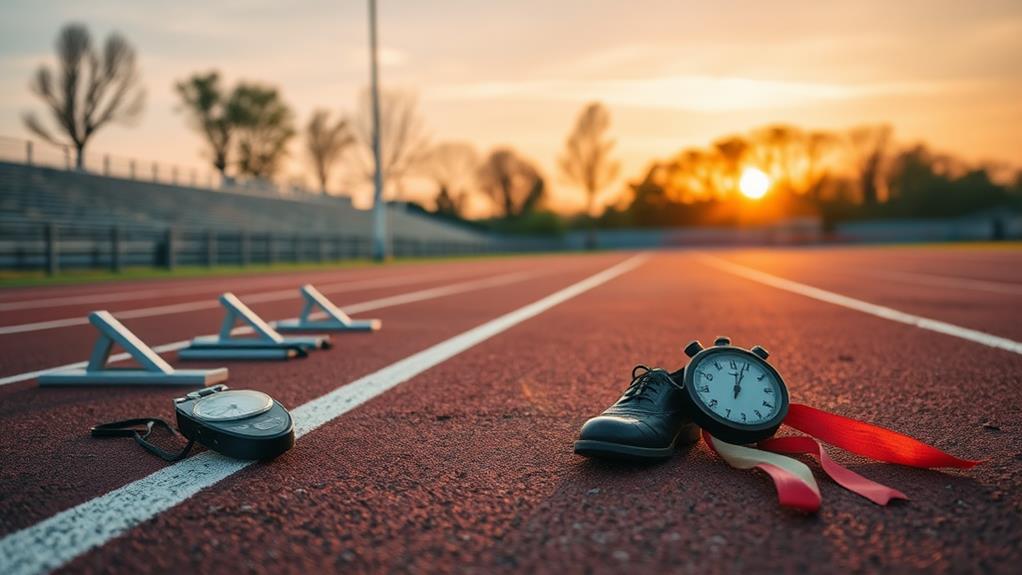
You might be surprised to learn that women’s participation in competitive running was largely absent until the 19th century. Despite the long history of running, women were often excluded from official events. However, the tide began to turn in the early 20th century. In 1926, Violet Piercy became one of the first women to run a marathon, though her achievement wasn’t officially recognized.
A major breakthrough came in 1967 when Kathrine Switzer became the first woman to officially run the Boston Marathon, challenging gender norms in the process. This milestone paved the way for future female athletes and sparked a gradual shift in attitudes. The modern Olympics finally included the first official women’s marathon in 1984, with Joan Benoit Samuelson claiming victory in Los Angeles.
Since then, women’s participation in running events has soared. By the early 21st century, about 60% of road race participants were female. Trail running has also seen increased female involvement, with 23% of participants being women. These statistics reflect the ongoing progress in gender representation within competitive running, showcasing how far the sport has come since its male-dominated beginnings.
Technological Advancements in Footwear
The evolution of running shoes has been nothing short of revolutionary. Since the 1960s, when Nike introduced the “Moon Shoe” with its innovative waffle sole, technological advancements have transformed athletic footwear. You’ve likely experienced the benefits of these improvements firsthand, from enhanced traction to superior cushioning.
The running shoe industry has made significant strides in performance and comfort. Here’s a glimpse of the key developments:
- Introduction of lightweight materials for speed-focused designs
- Development of breathable, moisture-wicking fabrics
- Implementation of cushioning technologies like Air and Gel systems
- Creation of specialized shoes for different running styles and terrains
These advancements have not only improved your running experience but also contributed to the growth of a multi-billion dollar industry. By 2019, the global athletic footwear market was valued at approximately $64 billion, reflecting the high demand for innovative running shoes.
As you lace up your shoes for your next run, remember that you’re benefiting from decades of technological progress. The shoes on your feet are the result of continuous research and development, aimed at enhancing your performance and comfort with every step.
Rise of Urban Running
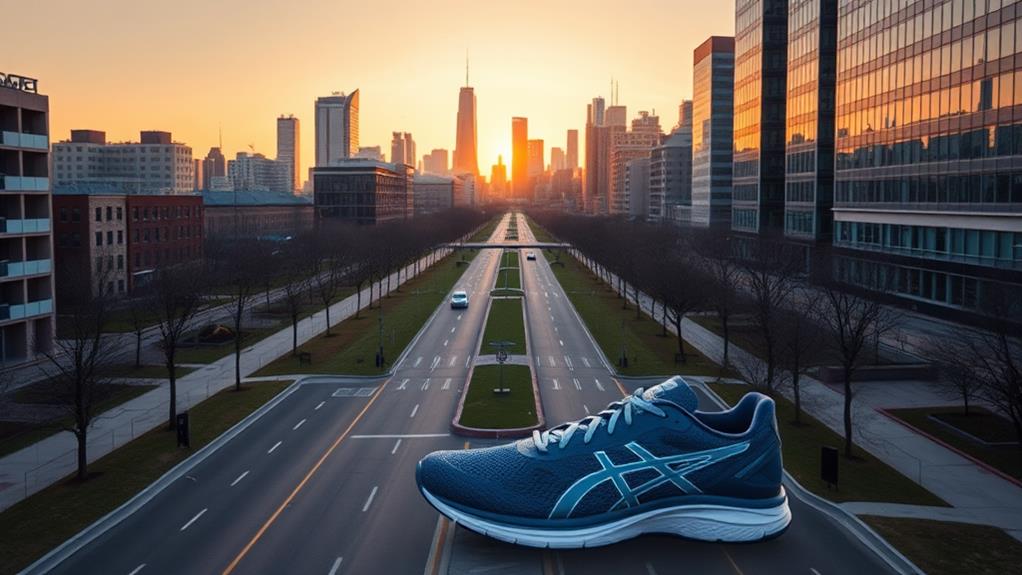
Emerging from the bustling streets and sidewalks of metropolitan areas, urban running has transformed the landscape of recreational fitness since the late 20th century. As part of the broader fitness movement of the 1970s, millions of Americans took up jogging in cities across the country. This surge in popularity led to the establishment of organized running events, such as city marathons and fun runs, which attracted thousands of participants annually.
Urban running clubs began to form in the 1980s and 1990s, fostering a sense of community among city dwellers. Organizations like the New York Road Runners played an essential role in popularizing the sport and organizing events. The rise of urban running was further propelled by technological advancements in running gear and apparel, making it more accessible and appealing to a wider audience.
Ultra-Marathon Phenomenon
Since the turn of the millennium, ultramarathons have captivated endurance enthusiasts and pushed the boundaries of human physical limits. These ultra-distance events, which exceed the standard marathon length of 42.195 kilometers, have seen a surge in popularity. From 2000 to 2019, participation in ultramarathons in the United States grew by an astounding 345%.
The ultramarathon phenomenon showcases the incredible potential of human endurance. Here are four key aspects of this modern running trend:
- Diverse challenges: Races range from 50 kilometers to multi-day events covering hundreds of miles
- Iconic courses: The Comrades Marathon and Ultra-Trail du Mont-Blanc offer unique terrains and stunning scenery
- Extreme elevation: Some races, like UTMB, feature elevation gains of up to 10,000 meters
- Record-breaking feats: Athletes like Eliud Kipchoge continue to redefine what’s possible in long-distance running
Ultramarathons have their roots in events like the Comrades Marathon, established in 1921. Today, they represent the pinnacle of endurance running, attracting athletes keen to test their limits. As the sport evolves, it continues to inspire runners worldwide and push the boundaries of human performance.
Trail Running’s Growing Popularity

While ultramarathons push the limits of human endurance, another running trend has been gaining momentum: trail running. Over the past decade, you’ve likely noticed an increase in trail running events and participants in your area. This surge in popularity isn’t just your imagination; trail running participation has grown by more than 80% from 2009 to 2019. The United States alone now hosts over 1,000 trail running events annually, catering to both competitive and recreational runners.
You might wonder what’s driving this trend. Trail running offers unique challenges with varied terrain and elevation changes, making it an appealing alternative to traditional road running. It’s not just about the physical challenge, though. Many runners are drawn to trail running as a way to connect with nature and enjoy outdoor activities. Women, in particular, have embraced this sport, with their participation rates in trail races increasing from 28% in 2000 to over 40% in recent years. Major events like the Western States 100 and Hardrock 100 have gained international recognition, attracting runners from around the world to test their skills on grueling courses.
Impact of Professional Running
Professional running has had a profound impact on the sport since its formal recognition at the first Olympic Games in 776 BCE. Over the centuries, running has evolved from ancient sprints to the modern marathon, which was introduced in the 1896 Olympics. The standardization of the marathon distance to 26.2 miles in 1921 marked a significant milestone in professional running‘s history.
The impact of professional running can be seen in several key areas:
- Increased participation and popularity
- Advancements in training techniques and equipment
- Economic growth through sponsorships and events
- Inspiration for recreational runners worldwide
The Boston Marathon, established in 1897, exemplifies the sport’s growing appeal, with participation soaring from 15 runners to over 20,000. Women’s participation in professional running, though limited until the late 20th century, made significant strides with the first official women’s marathon at the 1984 Olympics. The 1970s running boom, fueled by influential publications, led to a cultural shift that transformed running into a mainstream competitive sport. This boom resulted in millions of recreational runners in the U.S., further solidifying professional running’s impact on society and health.
Running as Physical Therapy
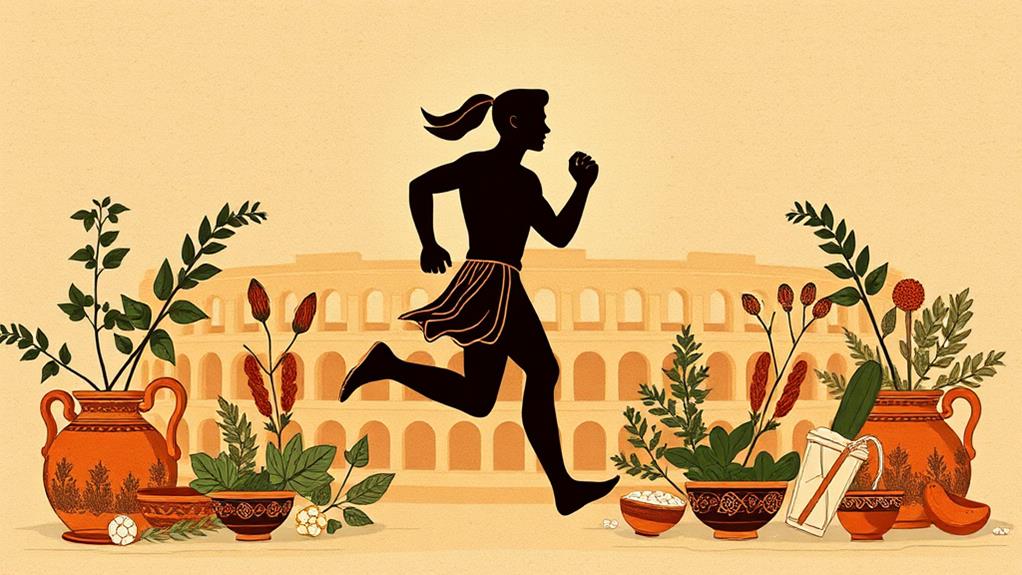
The therapeutic power of running extends far beyond its physical benefits. You’ll find that this fundamental human activity has become a valuable tool in physical therapy and rehabilitation programs. When you engage in regular running, you’re not just improving your cardiovascular health; you’re also boosting your mental well-being. Studies show that running can greatly reduce symptoms of anxiety and depression, making it an effective form of stress relief.
As you run, your body releases endorphins, which contribute to the famous “runner’s high,” promoting feelings of happiness and euphoria. This natural mood enhancer is one reason why physical therapists often incorporate running into treatment plans. Beyond mental health, running can enhance your cognitive function and memory, improving mental clarity and focus. Whether you’re recovering from an injury or seeking to improve your overall health, running as physical therapy offers a multitude of benefits. It helps strengthen muscles, increase flexibility, and improve cardiovascular endurance. By incorporating running into your routine, you’re taking a holistic approach to your health, addressing both physical and mental aspects of well-being.
Global Running Day Origins
Ever wonder how a global celebration of running came to be? Global Running Day, first celebrated on June 1, 2016, was initiated to encourage people of all ages and abilities to engage in running and promote the sport worldwide. The New York Road Runners (NYRR) organized this event, drawing on their experience with large-scale running events to foster a global community around running.
Here’s what Global Running Day aims to achieve:
- Inspire millions of runners across the globe to participate
- Host various events in cities and communities worldwide
- Offer activities like group runs, challenges, and virtual events
- Make running accessible to both experienced runners and newcomers
Each year, Global Running Day emphasizes the health benefits of running, motivating individuals to incorporate it into their daily routines. By highlighting running’s positive impact on fitness and well-being, the event encourages people to take their first steps towards a more active lifestyle. Through this annual celebration, the organizers have successfully created a platform that unites runners worldwide, promoting the sport and its numerous advantages for physical and mental health.
Future of Running Technology
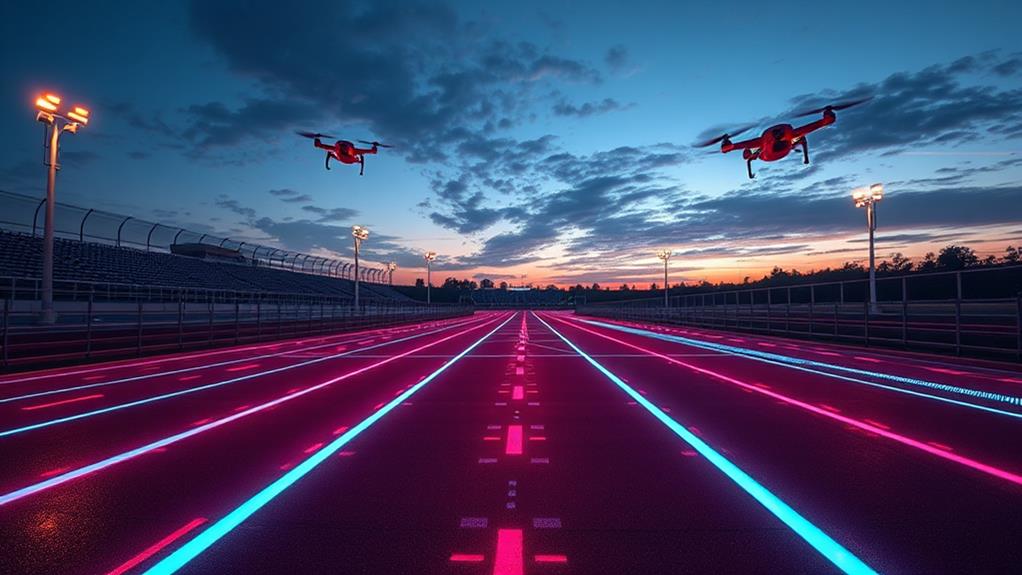
Countless innovations are shaping the future of running technology, revolutionizing how we approach this age-old activity. Advanced materials and designs in footwear are enhancing performance through improved cushioning and support, while simultaneously reducing injury risks. You’ll find smart running shoes equipped with embedded sensors, providing real-time data on your performance metrics to help optimize your training regimen.
AI-driven applications are emerging to offer personalized training plans tailored to your individual needs. These apps analyze your performance data and adjust workouts to maximize efficiency and results. Wearable technology, such as fitness trackers and smartwatches, continues to evolve, allowing you to monitor your heart rate, pace, and other essential statistics with unprecedented accuracy.
As environmental concerns grow, the development of environmentally conscious running apparel is gaining traction. Brands are focusing on sustainable materials and practices to meet the demands of eco-conscious consumers like yourself. These innovations not only improve your running experience but also contribute to a more sustainable future for the sport.

